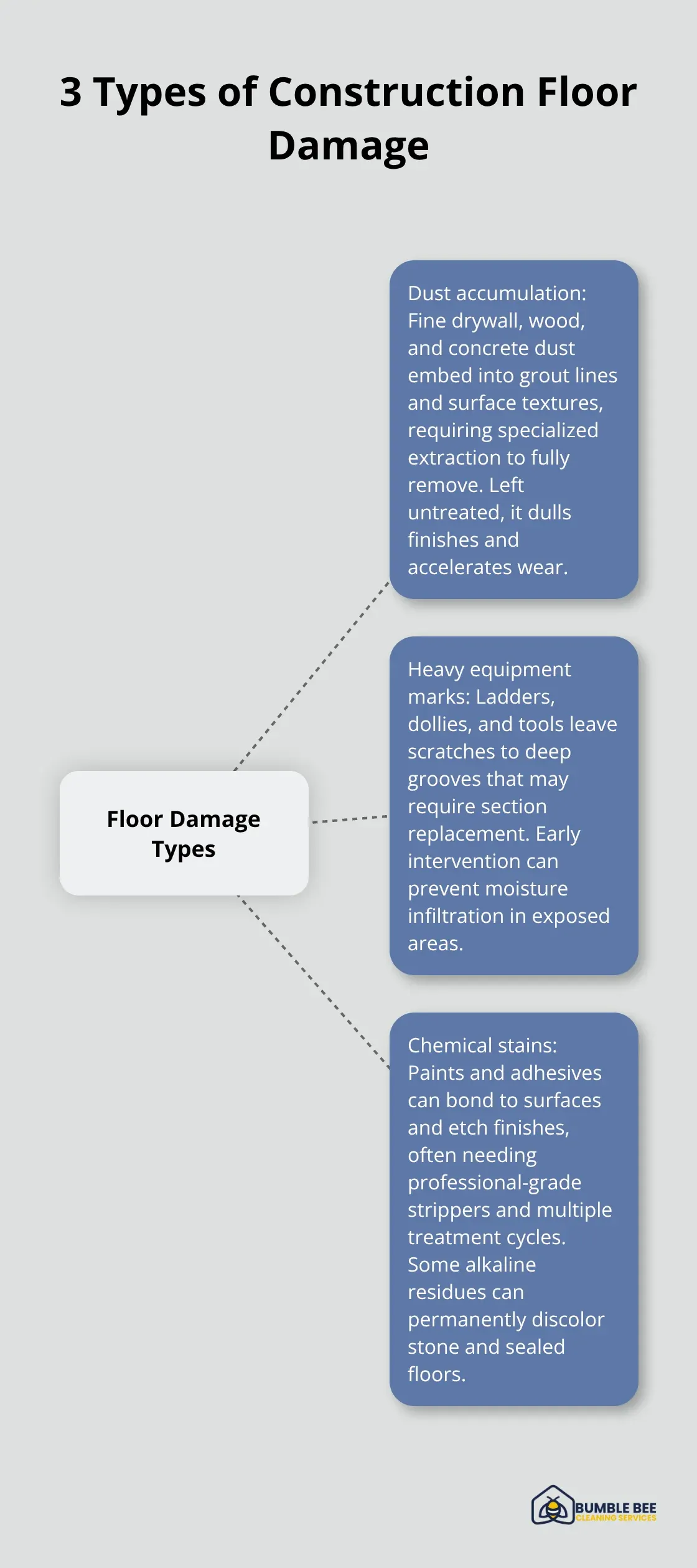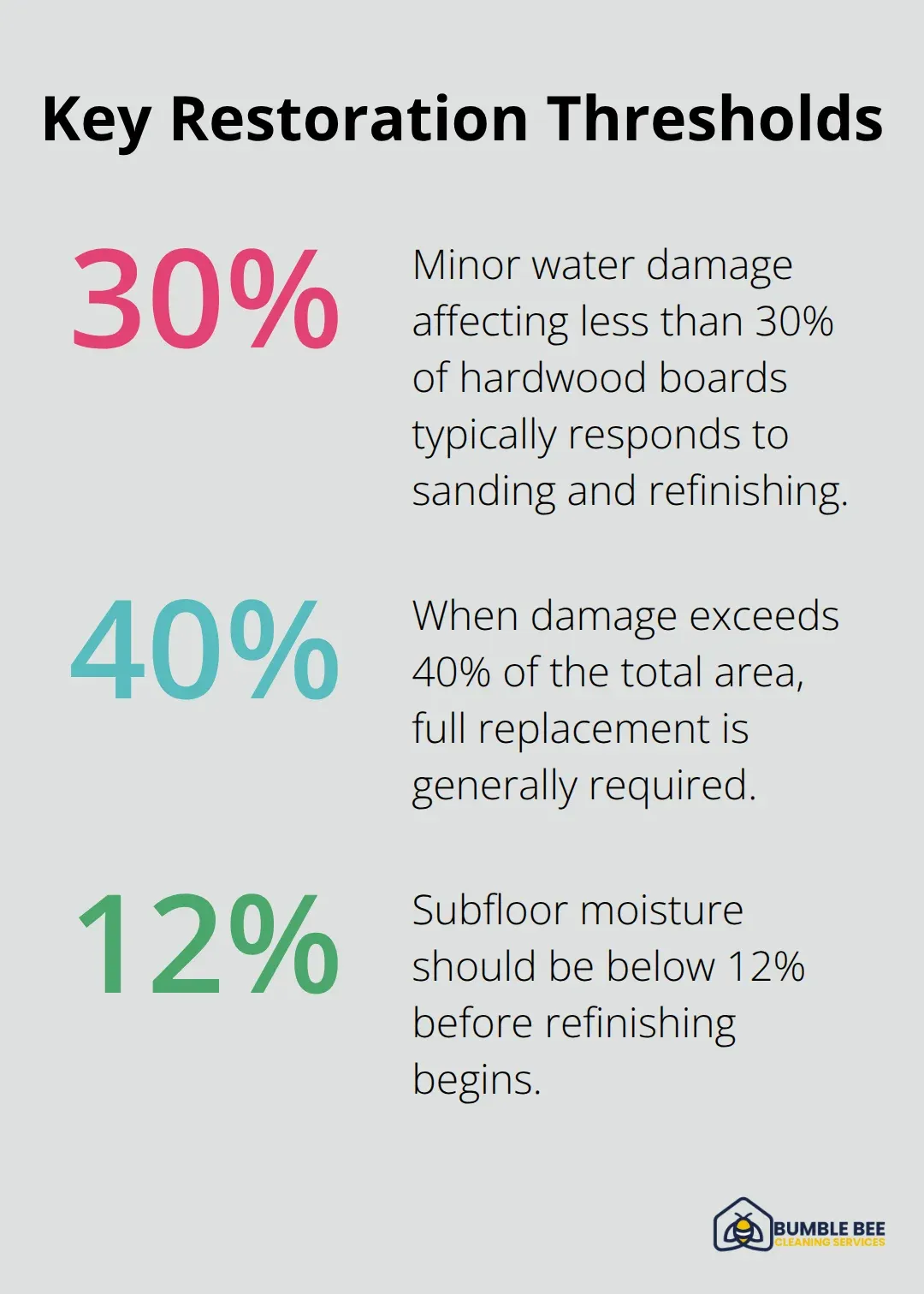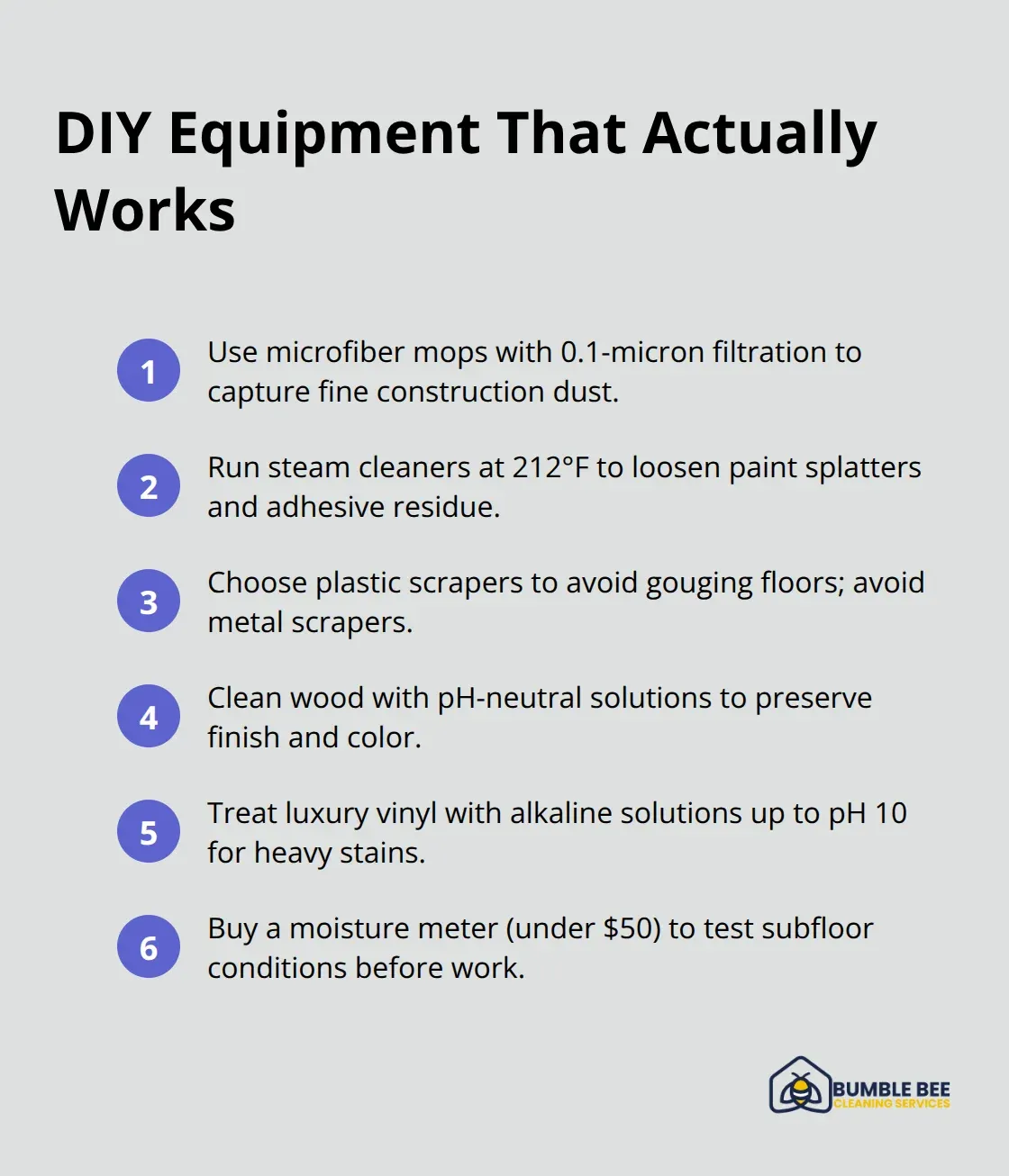Construction projects leave floors looking like disaster zones. Dust, scratches, and stubborn stains transform beautiful surfaces into eyesores that seem impossible to fix.
We at Bumble Bee Cleaning Services see this damage daily in Seattle homes and businesses. The good news? Floor restoration techniques can bring even the most beaten-up surfaces back to life without breaking your budget.
What Construction Damage Looks Like on Your Floors
Construction projects create three distinct types of floor damage that require different restoration approaches. Dust accumulation affects construction sites and forms thick layers that embed into floor surfaces and grout lines. This fine particulate matter contains drywall dust, wood shavings, and concrete particles that require specialized cleaning equipment including heavy-duty vacuum cleaners, pressure washers, and dust suppression systems for complete extraction.
Heavy Equipment Creates Deep Marks
Scratches and scuff marks from construction equipment create permanent damage on most floor types. Power tools, ladders, and material dollies leave gouges that range from surface-level scratches to deep grooves that require complete section replacement.

Hardwood floors show the most visible damage, with scratches that expose bare wood and need immediate attention to prevent moisture infiltration. Luxury vinyl and laminate surfaces develop white stress marks that standard cleaning methods cannot buff out.
Chemical Stains Demand Immediate Action
Paint spills, adhesive residue, and construction material stains create the most challenging restoration problems. Water-based paints remove within 24 hours when you use appropriate solvents, but oil-based products and construction adhesives bond permanently to floor surfaces. These chemical stains often require professional-grade strippers and multiple treatment cycles. Concrete dust mixed with moisture creates alkaline stains that etch into natural stone and sealed surfaces and causes permanent discoloration that requires refinishing or replacement.
Prevention Saves Money
Construction teams that protect floors during projects reduce restoration costs compared to unprotected surfaces. Drop cloths, protective films, and temporary flooring systems prevent most damage before it occurs. However, when damage does happen, professional restoration methods can address even severe problems and restore your floors to their original condition.
What Professional Methods Actually Restore Floors
Professional restoration begins with identification of the specific floor material and damage level before teams apply targeted treatments. Hardwood floors need different approaches than luxury vinyl or ceramic tiles, and the wrong method damages surfaces beyond repair. Industrial-grade equipment removes construction debris that household vacuums cannot handle, including concrete dust particles that measure less than 10 microns and embed deep into surface textures.
Deep Extraction Systems Remove Embedded Particles
Professional teams operate truck-mounted extraction systems that generate 240+ CFM airflow to pull embedded particles from grout lines and wood grain patterns. Steam treatment at 200+ degrees Fahrenheit dissolves adhesive residues and paint spills without chemical strippers that damage floor finishes.

The National Wood Flooring Association recommends pH-balanced cleaners for hardwood surfaces, while ceramic and stone floors handle alkaline solutions up to pH 12 for heavy-duty treatment. Water damage restoration requires moisture meters to measure subfloor conditions below 12% before refinishment begins.
Cost Analysis: Restoration vs Replacement
Minor water damage that affects less than 30% of hardwood boards responds well to targeted sanding and refinishment at $3-5 per square foot versus $8-12 for replacement. Surface scratches under 1/16 inch deep disappear through professional buffing and recoating processes (saving homeowners thousands compared to full replacement). However, floors with structural damage, mold growth, or damage that exceeds 40% of the total area need complete replacement.
Professional Assessment Tools Determine Success
Assessment tools including moisture meters and hardness testers determine whether restoration methods will produce results or temporary fixes that fail within months. Professionals measure wood density changes and subfloor moisture levels to predict long-term stability after restoration work. These diagnostic steps separate successful projects from costly failures that require additional work later.
While professional methods handle severe damage effectively, many homeowners can tackle minor issues with the right supplies and techniques.
Can You Fix Construction Floor Damage Yourself
Home restoration tackles minor construction damage through targeted techniques. Your success depends on accurate damage assessment and proper equipment selection, not expensive contractor estimates that often exceed actual repair needs.
Equipment That Actually Works
Microfiber mops with 0.1-micron filtration capture construction dust that standard tools spread around surfaces. Steam cleaners that operate at 212 degrees Fahrenheit dissolve paint splatters and adhesive residue without chemical strippers that damage floor finishes. Plastic scrapers remove dried materials without scratches, while metal scrapers create permanent gouges that require professional repair.
Wood floors need pH-neutral cleaners that clean and condition to restore natural beauty and luster. Luxury vinyl responds to alkaline solutions up to pH 10 for heavy stains. Purchase moisture meters under $50 to test subfloor conditions before you start restoration work on water-damaged areas.

Surface Repair Methods That Save Money
Light scratches under 1/32 inch deep disappear through walnut meat application, where natural oils fill microscopic gaps and blend with wood tones. Deep gouges that exceed 1/16 inch depth need wood filler that matches your floor color exactly. Sand filled areas with 220-grit paper after 24-hour cure times, then apply stain and polyurethane topcoat that matches.
Paint Removal Techniques
Paint removal requires heat guns set to 150 degrees maximum to soften materials without wood surface scorching. Chemical paint strippers work faster but create ventilation requirements and disposal challenges that increase project complexity. Always test removal methods on hidden floor areas first to prevent visible damage from incorrect technique application.
Final Thoughts
Floor restoration after construction projects requires you to match the right method to your specific damage type. DIY techniques handle surface scratches and minor stains effectively, while professional services tackle embedded debris and structural issues that household equipment cannot address. You need to assess damage severity before you choose between self-repair and professional intervention.
Professional post-construction cleanup delivers results that protect your floor investment long-term. Industrial extraction systems remove microscopic particles that cause wear, while specialized treatments restore original appearance without replacement costs (saving thousands compared to full floor replacement). We at Bumble Bee Cleaning Services restore all floor types without harsh chemicals that damage surfaces over time.
Proper floor care prevents future damage through regular maintenance schedules and protective measures during any home improvement work. Quality restoration work extends floor lifespan compared to neglected surfaces that require premature replacement. Professional post-construction cleaning addresses damage immediately before it becomes permanent, which maintains your home’s value and appearance.
